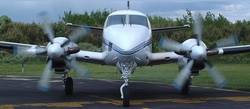Mon, Mar 31, 2003

A proposal to simplify and clarify the way aircraft operations
are classified in Australia has been published by the Civil
Aviation Safety Authority. The Classification of Operations
proposal features three classes of aircraft operations – air
transport, aerial work and general aviation.
The new classifications are put forward in a notice of proposed
rule making issued by CASA this month. Comments on the proposal
close on 12 May 2003.
 Everyone involved in Australian aviation is being
urged to study the new classification of operations policy as it
proposes a different way of classifying how aircraft are used in
the future. Key changes are the abolition of the charter category,
the listing of aerial work activities and the classification of all
operations that are not air transport or aerial work as general
aviation.
Everyone involved in Australian aviation is being
urged to study the new classification of operations policy as it
proposes a different way of classifying how aircraft are used in
the future. Key changes are the abolition of the charter category,
the listing of aerial work activities and the classification of all
operations that are not air transport or aerial work as general
aviation.
CASA’s executive manager Standards, Bill McIntyre, says
the proposals clear up a lot of the uncertainties in the current
classification of operations. “At the moment the definition
of aerial work is unclear and subject to interpretation,” Mr
McIntyre says.
“Under the proposed new rules aerial work operations would
be clearly set out and formally listed. If a flying activity is not
on the aerial work list, then it would not be classified as aerial
work.
“CASA is also proposing to ease the regulatory burden on
aerial work operators by replacing many air operators certificates
with a less onerous and more relevant operating
certificate.”
 The new air transport category would include all
fare-paying passenger-carrying operations, abolishing the separate
classifications for regular public transport and charter flights.
For some charter flights this would mean a lift in some safety
standards – although small operators will naturally not be
expected to meet the same standards as large air transport
carriers.
The new air transport category would include all
fare-paying passenger-carrying operations, abolishing the separate
classifications for regular public transport and charter flights.
For some charter flights this would mean a lift in some safety
standards – although small operators will naturally not be
expected to meet the same standards as large air transport
carriers.
“CASA believes fare paying passengers have the right to
appropriate safety standards, whether the flight is a scheduled
airline service or not. This means some smaller charter operators
would be required to meet higher standards,” Mr McIntyre
says.
More News
Pilot Applied Full Aft Stick And Nose-Up Trim, But The Airplane Remained On The Runway Analysis: The pilot reported that a preflight inspection and flight control checks revealed n>[...]
A Few Questions AND Answers To Help You Get MORE Out of ANN! 1) I forgot my password. How do I find it? 1) Easy... click here and give us your e-mail address--we'll send it to you >[...]
From 2022 (YouTube Edition): Before They’re All Gone... Humankind has been messing about in airplanes for almost 120-years. In that time, thousands of aircraft representing i>[...]
Advanced Air Mobility (AAM) A transportation system that transports people and property by air between two points in the NAS using aircraft with advanced technologies, including el>[...]
Aero Linx: MQ-1B Predator The MQ-1B Predator is an armed, multi-mission, medium-altitude, long-endurance remotely piloted aircraft that is employed primarily as an intelligence-col>[...]
 NTSB Final Report: Douglas A-4K
NTSB Final Report: Douglas A-4K ANN FAQ: Q&A 101
ANN FAQ: Q&A 101 Classic Aero-TV: PBY Catalina--From Wartime to Double Sunrise to the Long Sunset
Classic Aero-TV: PBY Catalina--From Wartime to Double Sunrise to the Long Sunset ANN's Daily Aero-Term (07.01.25): Advanced Air Mobility (AAM)
ANN's Daily Aero-Term (07.01.25): Advanced Air Mobility (AAM) ANN's Daily Aero-Linx (07.01.25)
ANN's Daily Aero-Linx (07.01.25)





